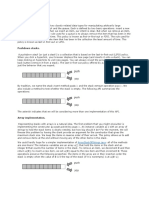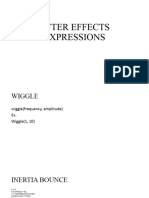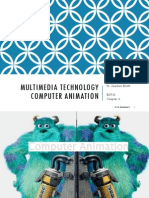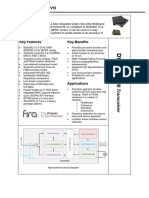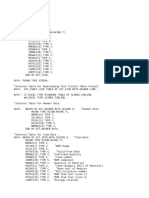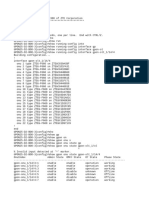0 ratings0% found this document useful (0 votes)
155 viewsComputer Animation
Computer animation involves generating animated images using computer graphics. Modern animation typically uses 3D graphics, though 2D is still used. Animation works by displaying a series of images fast enough to create the illusion of movement, with a minimum of 12 frames per second needed.
Uploaded by
AmberShahCopyright
© © All Rights Reserved
Available Formats
Download as PPTX, PDF, TXT or read online on Scribd
0 ratings0% found this document useful (0 votes)
155 viewsComputer Animation
Computer animation involves generating animated images using computer graphics. Modern animation typically uses 3D graphics, though 2D is still used. Animation works by displaying a series of images fast enough to create the illusion of movement, with a minimum of 12 frames per second needed.
Uploaded by
AmberShahCopyright
© © All Rights Reserved
Available Formats
Download as PPTX, PDF, TXT or read online on Scribd
You are on page 1/ 42
Computer animation is the process used for
generating animated images by using computer
graphics.
Modern computer animation usually
uses 3D computer graphics, although 2D computer
graphics are still used for stylistic, low bandwidth, and
faster real-time renderings.
Computer animation only refers to moving images
produced by exploiting the persistence of vision to
make a series of images look animated.
To trick the eye and brain into thinking they are seeing
a smoothly moving object, the pictures should be
drawn at around 12 frames per second (frame/s) or
faster (a frame is one complete image).
Hand drawn cartoons runs at 15 frames per second.
Animated movies runs at 24 frames per second, which
is sufficient to create the illusion of continuous
movement. For high resolution, adapters are used.
Computing each frame would take too long.
Mesh
3D animation is digitally modeled and manipulated by an
animator.
The animator starts by creating an external 3D mesh to
manipulate.
A mesh is a geometric configuration that gives the visual
appearance of form to a 3D object or 3D environment.
The mesh may have many vertices which are the geometric
points which make up the mesh; it is given an internal
digital skeletal structure called an armature that can be
used to control the mesh with weights.
This process is called rigging and can be programmed for
movement with keyframes.
Animation Techniques- Present
3D Animation
Early 2D Animation: Used traditional techniques
Early 3D Animation: Neglected traditional
techniques.
Virtual world where objects and characters can
interact with one another.
3 Main components of 3D Animation.
Model, describing the elements of a scene.
Animate, specifies how the objects move in the
environment.
Render, coverts the information (object and their
motion) into images.
Animation Tecniques-
KeyFraming
A key frame in animation and filmmaking is a
drawing that defines the starting and ending points of
any smooth transition.
A sequence of key frames defines which movement the
viewer will see, whereas the position of the key frames
on the film, video or animation defines the timing of
the movement.
At key frames, animator positions objects and
lights, sets parameters, etc.
Because only two or three keyframes over the span
of a second do not create the illusion of
movement.
Interpolate the remaining frames in-between these
key frames (in-betweening).
Interpolation is creating a new position between
existing positions
Systems uses spline interpolation to control the
path of an object.
Applied to color transformations, shape
transformations, motion of an object.
Linear Interpolation
The easiest form of interpolation
Given the same point in two different keyframes, a line
is drawn between them
The new point exists somewhere on this line.
Done for every point and combined to make a new
keyframe
Disadvantage: the formula doesnt always give a good
approximation of the points
Spline Interpolation
This method shares the same idea as linear
interpolation
Considers two frames before and after the desired new
frame, instead of one before and after
Point approximation is more accurate than linear
interpolation
Animation Techniques
Modeling Articulated Model
Collection of objects
connected together by joints.
The collection of joints
resembles a Hierarchy tree-
like structure.
Moving the elbow would
affect the location of the
wrists position.
Animation Techniques
Modeling Particle System
Collection of points in space.
Particles move or collide with each other is decided by
a set motion.
A set motion is determined by a set of rules, i.e.: The
laws of physics.
Examples are watersplash, smoke, a flock of birds
flying.
Animation Techniques
Modeling Deformable Objects
Models similar to articulated but without the defined
joints.
The structure of the object is too great to implement
joints.
Examples: water, hair, rocks, ground.
Animation Techniques
Modeling
The diver
represents an
articulated object
The body of water
is a deformed
object.
The splash of
course would be
a particle system
Animation Techniques-
3D Rotoscoping
Rotoscoping is an animation technique in
which animators trace over footage, frame by frame,
for use in live-action and animated films.
Rotoscoping (often abbreviated as "roto") has often
been used as a tool for visual effects in live-
action movies.
By tracing an object, a silhouette (called a matte) is
created that can be used to extract that object from a
scene for use on a different background.
Kinematics
One method to constrain an animation of human or
animal figures is to use a jointed skeletons.
The skeleton is made up of a set of links. Each link in
the chain is rigid, and the movement is constrained by
the degree of freedom at each joint.
The skeleton can be fleshed out in any way to create
the animated figure.
Kinematics determines parameters needed for a
jointed, flexible object to achieve a pose
Factors in maintaining balance, joint angle limitations,
and collisions between the body and limbs.
Two ways of doing this
Inverse Kinematics
Inverse Kinematics: figure out what angles
joints will need in order to achieve a pose,
given the desired configuration based on a
hierarchy.
Specify the position of one object and every
object above it in the hierarchy. Motion is
inherited up.
To perform one action must be able to move
multiple joints.
Example: to move the arm and torso to one
position, the algorithm can figure the position of
where the shoulder and elbow should be.
Factors in maintaining balance, joint angle
limitations, and collisions between the body
and limbs.
Disadvantage: There is no general analytical
solution
Must be solved through non-linear
programming techniques
Forward Kinematics
Forward Kinematic Animation: given desired angle
changes for the figures joints will result in a pose.
Motion is inherited down the hierarchy.
Easier than inverse kinematics
Motion Capture
Motion capture is the process of recording a live
motion event and translating it into actionable data
that allows for a 3d recreation of the performance. In
other words, transforming a live performance into a
digital performance.
A person wears sensors near each joint.
Computer software records positions, angles,
velocities, accelerations, and impulses for all
sensors.
Animation Method-
Morph Target Animation
In a morph target animation, a "deformed" version of a
mesh is stored as a series of vertex positions.
In each key frame of an animation, the vertices are
then interpolated between these stored positions.
The "morph target" is a deformed version of a shape.
When applied to a human face, for example, the head is
first modelled with a neutral expression and a "target
deformation" is then created for each other expression.
When the face is being animated, the animator can then
smoothly morph (or "blend") between the base shape and
one or several morph targets.
Typical examples of morph targets used in facial
animation is a smiling mouth, a closed eye, and a
raised eyebrow,
There are advantages to using morph target animation
over skeletal animation.
The artist has more control over the movements
because he or she can define the individual positions
of the vertices within a keyframe, rather than being
constrained by skeletons.
This can be useful for animating cloth, skin, and facial
expressions because it can be difficult to conform
those things to the bones that are required for skeletal
animation.
Motion Capture
Advantages:
Faster than manually creating animations
Can have much more natural looking motions and catch
subtleties of the object.
Disadvantages:
Cant do anatomically impossible motions
Motion is restricted to the laws of physics.
Sensors attached to the skin can shift out of position
during human movement causing real performance to
differ from data recorded.
12 Principles of Animation
Squash & Stretch.
Anticipation.
Staging.
Straight Ahead Action & Pose-To-Pose.
Follow Through & Overlapping Action.
Slow-In & Slow-Out.
Arcs.
Secondary Action.
Timing.
Exaggeration.
Solid Modeling & Rigging.
Character Personality.
Squash & Stretch
The most important principle is "squash and stretch.
The purpose of which is to give a sense of weight and
flexibility to drawn objects.
It can be applied to simple objects, like a bouncing
ball, or more complex constructions, like the
musculature of a human face.
The most important aspect of this principle is the fact
that an object's volume does not change when
squashed or stretched.
If the length of a ball is stretched vertically, its width
(in three dimensions, also its depth) needs to contract
correspondingly horizontally.
Three-dimensional squash and stretch can be
implemented with a variety of techniques: skin and
muscle, springs, direct mesh manipulation and
morphing.
Anticipation
Anticipation is used to prepare the audience for an
action, and to make the action appear more realistic.
A dancer jumping off the floor has to bend his knees
first; a golfer making a swing has to swing the club
back first.
In three-dimensional computer animation it can be
fine-tuned using digital time-editing tools such as
time sheets, timelines, and curves.
More anticipation equals less suspense. Horror films,
for example, switch back and forth from lots of
anticipation to total surprise.
Example:
Goofy prepares to hit a baseball.
Staging
This principle is akin to staging as it is known in
theatre and film.
Its purpose is to direct the audience's attention, and
make it clear what is of greatest importance in a scene;
This can be done by various means, such as the
placement of a character in the frame, the use of light
and shadow, and the angle and position of the camera.
Straight Ahead Action & Pose To
Pose.
These are two different approaches to the actual
drawing process.
"Straight ahead action" means drawing out a scene
frame by frame from beginning to end.
While "pose to pose" involves starting with drawing a
few key frames, and then filling in the intervals later.
Motion capture and dynamics simulations, even three-
dimensional rotoscoping , are clearly the straight-
ahead techniques of three-dimensional computer
animation.
They can all be blended intelligently using channels.
Follow through & Overlapping
Follow-through action consists of the reactions of
the character after an action, and it usually lets
audiences know how he or she feels about what has
just happened or is about to happen.
Example: after throwing a ball.
In overlapping action: starting a second action
before the first has completed.
The layers and channels in three-dimensional
computer animation software allow us to mix and
blend different overlapping motions from different
areas of the character.
Slow-In & Slow-Out
Slow-in and slow-out consist of slowing down the
beginning and the end of an action, while speeding up
the middle of it.
In three-dimensional computer animation slow-ins
and slow-outs can be fine-tuned with digital time-
editing tools.
Arcs
Using arcs to animate the movements of characters
helps achieve a natural look because most living
creatures move in curved paths, never in perfectly
straight lines.
In three-dimensional computer animation we can use
software constraints to force all or some of the motion
within arcs.
Timing
Timing is the precise moment and the amount of time
that a character spends on an action.
Most three-dimensional computer animation tools
allow us to fine tune the timing by shaving off or
adding frames with non-linear time-editing.
Timing can also be controlled and adjusted by placing
each character on a separate track, and using sub-
tracks for parts of the character such as head, torso,
arms and legs.
Exaggeration
Usually helps cartoon characters to deliver the essence
of an action. A lot of exaggeration can be achieved
with squash and stretch.
In three-dimensional computer animation we can use
procedural techniques, motion ranges and scripts to
exaggerate motion.
Solid Modelling & Rigging
Solid and precise modeling helps to convey the weight,
depth and balance of the character, and it also
simplifies potential production complications due to
poorly modeled characters.
Animation rigs are at their best when they are
optimized for the specific personality and motion of
the character.
Character Personality
Character personality, or appeal as it was originally
called, facilitates the emotional connection between
character and audience.
Characters must be well developed, have an interesting
personality, and have a clear set of desires or needs
that drive their behavior and actions.
Complexity and consistency of motion are two
elements of character appeal that can be easily
developed with three-dimensional computer
animation.
New 3D Principles
A few of the new issues that need to be addressed by
new principles of three-dimensional computer
animation include:
visual styling,
blending cartoon physics with real world physics,
using cinematography,
mastering facial animation,
and optimizing user-controlled animation.
Visual Styling
Visual styling has a significant impact on rendering,
on animation techniques, and overall production
complexity.
As we develop a visual look we must keep in mind that
it is feasible to produce within the boundaries of the
project.
A certain look for the skin of a beast, for example,
might look cool but might also require too complex a
rig, too detailed a model and too complex an
animation process.
Blending Motion
It is possible today to blend motion from different
sources, and we need to develop a clear approach for
blending cartoon with realistic motion.
Before production starts it is necessary to define clear
guidelines for a variety of motion/animation styles
including cartoon physics, realistic cartoon, realistic
human motion and rotoscoping.
Cinematography
Since we have absolute control over camera positions
and movement in three-dimensional computer
animation, we should make the cinematography a
crucial component of our animation, not just an
afterthought.
The composition, lighting, and sequencing of our
moving images has a huge impact on storytelling.
The lighting style needs to be addressed separately,
since it impacts both the look and the rendering
pipeline.
Facial Animation
Three-dimensional computer animation offers more
facial animation control than ever before, including
the subtle motion of eyelids and eyeballs.
Establishing early in the process the level of facial
control and techniques has a positive effect on the
styling of the character and the design of the
production flow.
User-Controlled Animation
Computer and platform games put much of the
animation control in the hands of gamers.
This poses the challenge to create great animation that
works regardless of what move the gamer decides to
make.
Games are a combination of user-controlled
animation and preset/narrative animation.
User-controlled animation relies on strong animation
cycles with built-in anticipation that are able to branch
smoothly into reaction shots.
You might also like
- Creating 3D Animations & Game Assets With AINo ratings yetCreating 3D Animations & Game Assets With AI14 pages
- Hands-On Deep Learning For Images With T PDFNo ratings yetHands-On Deep Learning For Images With T PDF3 pages
- How To Start A Research Work in Computer Science PDFNo ratings yetHow To Start A Research Work in Computer Science PDF4 pages
- CSC 221 DSA Queue Arrays - Linked List Implementation 10032023 055715pmNo ratings yetCSC 221 DSA Queue Arrays - Linked List Implementation 10032023 055715pm59 pages
- Computer Graphics Ii: Opengl IntroductionNo ratings yetComputer Graphics Ii: Opengl Introduction24 pages
- SQL Server 2012 Tutorials - Analysis Services Data MiningNo ratings yetSQL Server 2012 Tutorials - Analysis Services Data Mining215 pages
- Claude and ChatGPT Data Analysis PromptsNo ratings yetClaude and ChatGPT Data Analysis Prompts7 pages
- Bitcoin-NG A Scalable Blockchain Protocol-4No ratings yetBitcoin-NG A Scalable Blockchain Protocol-429 pages
- Name of The Lab (Multimedia Technologies)No ratings yetName of The Lab (Multimedia Technologies)11 pages
- Introduction To Gpu Programming With Cuda and Openacc100% (1)Introduction To Gpu Programming With Cuda and Openacc40 pages
- Software Engineering Cheat Sheet: by ViaNo ratings yetSoftware Engineering Cheat Sheet: by Via2 pages
- Procedural Wear From A To Z in Blender PDFNo ratings yetProcedural Wear From A To Z in Blender PDF198 pages
- Chapter 6 - Computer Animation Types and Techniques100% (1)Chapter 6 - Computer Animation Types and Techniques93 pages
- Mathematics For Senior Phase Booklet Grades 7 9No ratings yetMathematics For Senior Phase Booklet Grades 7 9126 pages
- Y5 Autumn Block 5 Wo3 Area of Rectangles 2019No ratings yetY5 Autumn Block 5 Wo3 Area of Rectangles 20192 pages
- Bidirectional power flow in an electric vehicle using predictive control algorithm including sneak circuit analysisNo ratings yetBidirectional power flow in an electric vehicle using predictive control algorithm including sneak circuit analysis12 pages
- Hybrid Beamforming For DFRC System Based On SINR Performance MetricNo ratings yetHybrid Beamforming For DFRC System Based On SINR Performance Metric6 pages
- Handling Precautions: Butterfly Valves (Common To All Models)No ratings yetHandling Precautions: Butterfly Valves (Common To All Models)9 pages
- Smart Automated Irrigation System (IOT) : A Seminar Report OnNo ratings yetSmart Automated Irrigation System (IOT) : A Seminar Report On30 pages
- Data Sheet For Three-Phase Squirrel-Cage-Motors SIMOTICS: Motor Type: SD100 FS: 286T - 4p - 30 HPNo ratings yetData Sheet For Three-Phase Squirrel-Cage-Motors SIMOTICS: Motor Type: SD100 FS: 286T - 4p - 30 HP5 pages
- Traffic Congestion Problem and SolutionsNo ratings yetTraffic Congestion Problem and Solutions11 pages
- (EN-423) RENEWABLE Energy Resources: Lecture 12 - Geothermal Energy (Geothermal Systems)No ratings yet(EN-423) RENEWABLE Energy Resources: Lecture 12 - Geothermal Energy (Geothermal Systems)32 pages
- How To Start A Research Work in Computer Science PDFHow To Start A Research Work in Computer Science PDF
- Mastering Autodesk Maya 2016: Autodesk Official PressFrom EverandMastering Autodesk Maya 2016: Autodesk Official Press
- Image Segmentation: Unlocking Insights through Pixel PrecisionFrom EverandImage Segmentation: Unlocking Insights through Pixel Precision
- CSC 221 DSA Queue Arrays - Linked List Implementation 10032023 055715pmCSC 221 DSA Queue Arrays - Linked List Implementation 10032023 055715pm
- SQL Server 2012 Tutorials - Analysis Services Data MiningSQL Server 2012 Tutorials - Analysis Services Data Mining
- Introduction To Gpu Programming With Cuda and OpenaccIntroduction To Gpu Programming With Cuda and Openacc
- Chapter 6 - Computer Animation Types and TechniquesChapter 6 - Computer Animation Types and Techniques
- Bidirectional power flow in an electric vehicle using predictive control algorithm including sneak circuit analysisBidirectional power flow in an electric vehicle using predictive control algorithm including sneak circuit analysis
- Hybrid Beamforming For DFRC System Based On SINR Performance MetricHybrid Beamforming For DFRC System Based On SINR Performance Metric
- Handling Precautions: Butterfly Valves (Common To All Models)Handling Precautions: Butterfly Valves (Common To All Models)
- Smart Automated Irrigation System (IOT) : A Seminar Report OnSmart Automated Irrigation System (IOT) : A Seminar Report On
- Data Sheet For Three-Phase Squirrel-Cage-Motors SIMOTICS: Motor Type: SD100 FS: 286T - 4p - 30 HPData Sheet For Three-Phase Squirrel-Cage-Motors SIMOTICS: Motor Type: SD100 FS: 286T - 4p - 30 HP
- (EN-423) RENEWABLE Energy Resources: Lecture 12 - Geothermal Energy (Geothermal Systems)(EN-423) RENEWABLE Energy Resources: Lecture 12 - Geothermal Energy (Geothermal Systems)








